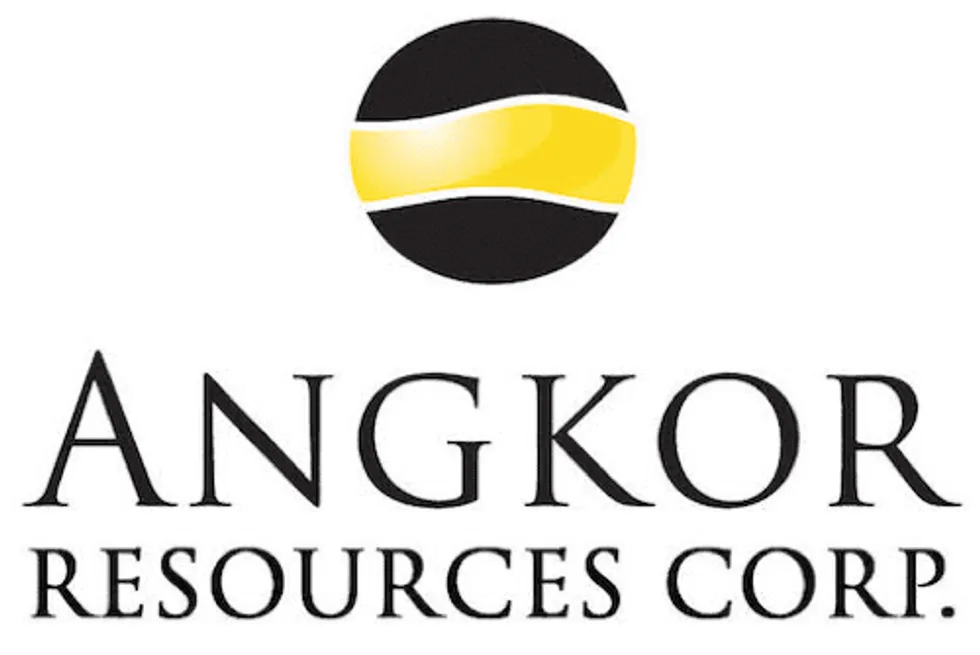Andong Meas
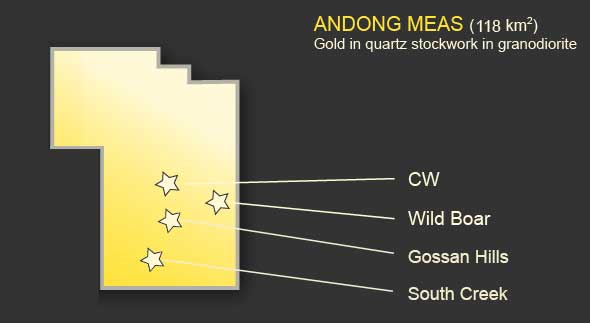
Andong Meas is located is 50 kilometres east of the provincial capital Banlung along a paved highway. Andong Meas Exploration License has always been an attractive property for mineral exploration based on the intensity of historical and recent artisanal workings.
Angkor Resources has worked significant portion of the tenement and identified several prospects. Canada Wall is a copper/gold/molybdenum porphyry system. Wild Boar, situated several kilometres to the east of Canada Wall, is an epithermal gold vein system. Gossan Hills sits about two kilometres south of Canada Wall and appears to be a skarn with copper and rare earth elements indicated. South Creek is further south yet and hosts additional copper /molybdenum mineralization.
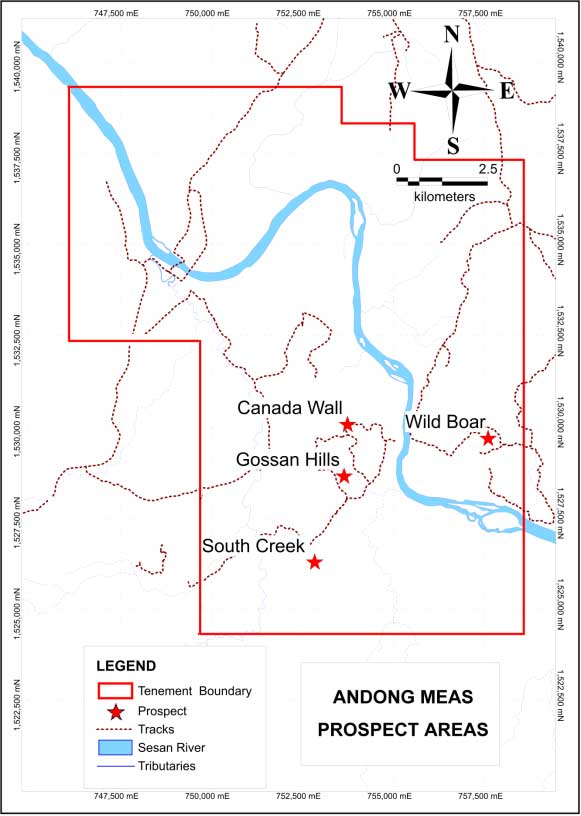
The 118 km2 exploration license has demonstrated to have a lot of potential for developing porphyry style mineralization and epithermal vein systems related to precious metal deposition. The host rock unit is the Andong Meas granitoid complex (granodiorite/granite) located in the centre of the license and elongated northwest to southeast. This intrusive complex has been intruded by multiple events of younger intrusive rocks which generated copper-molybdenum mineralization as well as quartz vein systems with gold mineralization.
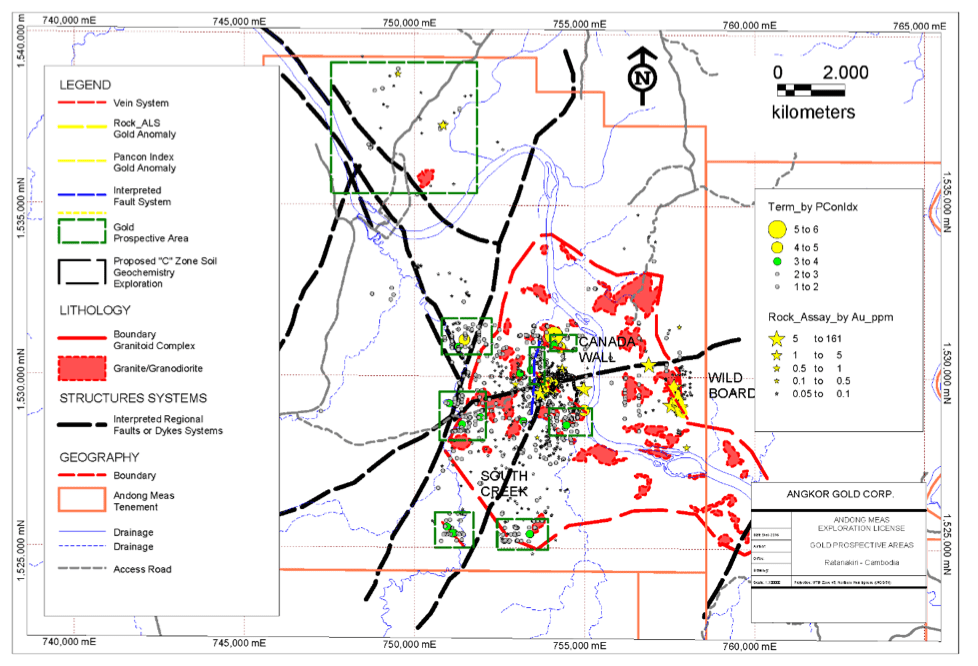
The entire license area has been the subject of an aeromagnetic survey, satellite imagery geological interpretation, with reconnaissance field truth mapping and multi-element stream sediment geochemical survey, taking samples from catchments of roughly 1km² extents. These efforts highlighted several areas as specific targets for more intensive work. A follow-up reconnaissance termite mound geochemical survey was undertaken, coupled with more detailed geological reconnaissance mapping. These latter surveys were ones of simple trail walking, recording data and collecting samples as opportunity presented itself. In addition, two areas were singled out for special attention.
The one prospect, Wild Boar, is an area of intensive artisanal workings on several subparallel epithermal veins. These workings have been cleaned, sampled and surveyed. An area of 1km² has been the subject of a detailed termite mound geochemical survey (800 samples) on a 200m x 200m grid.
Work through to May of 2023 has included detailed mapping and rock sampling of quartz vein float. The mapping has revealed that the mineralization is hosted by granodiorite within an anticlinal fold of the basement metamorphic sequence which in places contains calcareous units. An IP survey was completed over the target area in 2021 resulting in vein/alteration type responses on lines that were surveyed over areas which had produced gold mineralized quartz vein float and contain numerous artisanal mining pits.
Ground magnetic surveys were carried out over the main CW area as well as the target area of Wild Boar. The ground magnetic survey was expanded at CW south to continuously cover the Gossan Hills area and further south to cover the South Creek copper porphyry target. That data will be reprocessed in the coming months taking into account the reinterpretation of geology from core and from ground mapping in recent years.
In 2023, two large trenches were excavated using local labour on the Wild Boar. The trenches showed flat, south dipping faults offsetting intensely altered granodiorite sitting above relatively unaltered granodiorite. The altered zone contained multiple vertical quartz-calcite tension fractures. The trenches are within the weathered saprolitic zone. Many samples collected and were panned for visible gold. Of the 184 samples collected, 98 had gold panned from them for a 53% success rate even though there were no quartz veins found in the trenches.
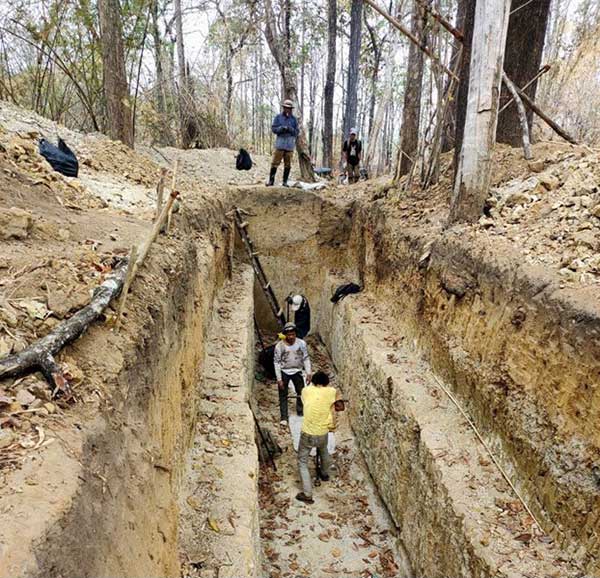
Sampling of Trench 1

IP survey at the Wild Boar showing possible vein structures and altered wall rock.
Extensive artisanal workings, including an illegal open pit mine and several underground adits and raises, occur over the area known as Canada Wall (CW) prospect. Many shallow artisanal pits and some deeper (2 to 3 meter) shafts were found and surveyed at the Wild Boar prospect as well. A program of 3 diamond drill scout holes, totalling 521m was drilled on the CW prospect in 2012 followed by three more in 2015.
The 2012 drill holes were centered on the quartz breccia zone that had been the target of the artisanal miners’ pit and adits. Although abundant quartz was encountered, the gold and silver levels were sub-economic. However, the holes also cored a thick aplite dike and below that, diorite dikes which were weakly potassic altered with biotite replacing hornblende. Copper values returned in the high 100’s of ppm with some into the low thousands of ppm. Copper mineralization consisted of minor chalcopyrite with pyrite in narrow quartz veins cutting the altered diorite. These features are consistent with copper porphyry mineralization.
The 2015 holes were drilled east and north of the preliminary holes and targeted molybdenum mineralization discovered in outcrop veins within medium to coarse grained granodiorite. Although there were some interesting short intercepts of molybdenum mineralization, the more interesting unit cored was a quartz-granodiorite breccia in DDH CW15-005. Some of the quartz breccia fragments contain semi-massive to massive pyrrhotite and chalcopyrite and are cut by narrow molybdenum veinlets. The breccia continued to end-of-hole for 68 meters.
Four additional holes were drilled in 2021. Three holes targeted the newly discovered Gossan Hill zone one kilometer south of the main CW target area. The Gossan Hills area features copper, lead, zinc skarns in calcareous sediments at the contact with granodiorite. The three short holes showed that the mineralization is both sporadic and narrow. Massive hematite and magnetite zones are also found in the area probably representing the distal zone of a much larger skarn zone at depth. It is not uncommon to have skarns associated with copper porphyry deposits.
Hole CW21-010 was drilled just north of the 2012 holes and consisted of weakly mineralized diorite displaying weak potassic alteration and retrograde propylitic alteration. This hole is clearly well above the main copper porphyry mineralization.
Subscribe to our email list and stay connected with Angkor Resources Corp.!
Sign up now to receive exclusive updates and valuable insights straight to your inbox. Join our community of like-minded individuals who are passionate about the future of resource exploration and development. Don’t miss out on the latest news, industry trends, and exciting opportunities. Simply enter your email address and be part of the Angkor Resources Corp. family today.
